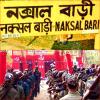Naxal Violence: India’s Achilles Heel
In comparison to the indiscriminate violence perpetrated by Islamic terrorists, the Naxal menace (also infamous as Left-wing Extremist or Maoist) has been plaguing India for quite some time as one of the biggest internal security challenges. The most affected Chattisgarh state has witnessed one of the worst ever massacre on 17 July when armed Naxalites attacked the Errabore Relief Camp in Dantewada district, killing some 30 unarmed civilians and injuring scores. The attackers have abducted more than 45 people in that fateful night.







